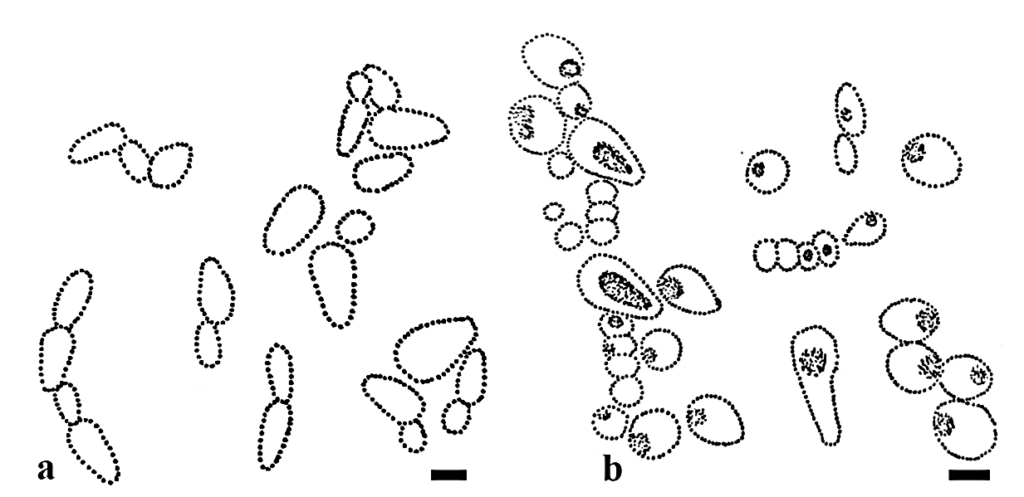Fungalpedia – Note 44 Millerozyma
Millerozyma Kurtzman & M. Suzuki
Citation if using this entry: Fallahi et al. (2023) New genera in 2010-2011. Mycosphere (in prep)
Index Fungorum, MycoBank, GenBank, Fig1
To evaluate the evolutionary position of the yeast species of Pichia and species from nearby genera that make coenzyme Q-9, Kurtzman and Suzuki (2010) surveyed the divergent domains of the large subunit (D1/D2) and the almost complete small subunit rDNA (18S rDNA). They proposed the genus Millerozyma in Debaryomycetaceae (Saccharomycetales), with two ascomycetous yeast species, Millerozyma acaciae, and Millerozyma farinosa. Later, Tammawong et al. (2010), based on phenotypic and phylogenetic data (based on D1/D2 domain of LSU rDNA and ITS), added Millerozyma phetchabunensis to this genus. They also transferred Pichia koratensis, which was placed in the Millerozyma clade, to Millerozyma as Millerozyma koratensis. Mallet et al. (2012) also proposed Millerozyma miso as a new species in this genus. The genus members are characterized by conjugated asci between a parent cell and its bud, or between independent cells, with 1‒4 ascospores that may be hat-shaped with a narrow brim or spherical to ovoid with a subequatorial ledge. Asexual reproduction occurs by multilateral budding. Pseudohyphae are developed but true hyphae are absent. Coenzyme Q9 is the major ubiquinone in the genus and the diazonium blue B test is negative (Kurtzman and Suzuki. 2010).
Fig 1– Micrograph of cells of Millerozyma miso (redrawn from Mallet et al. 2012). a vegetative cell grown on YPD agar. b Sporulating cells after two weeks on Malt agar. Scale bars= 5 µm.
Type speciea: Millerozyma farinosa (Lindner) Kurtzman & M. Suzuki
Other accepted species:
Millerozyma acaciae (Van der Walt) Kurtzman & M. Suzuki
Millerozyma koratensis (Nakase, Jindam., Mikata, Ninomiya, H. Kawas. & Limtong) Tammaw., Ninomiya, H. Kawas., Boonchird
Millerozyma miso Mogi ex S. Mallet, S. Weiss, N. Jacques & Casarég.
Millerozyma phetchabunensis Tammaw., Ninomiya, H. Kawas., Boonchird & Sumpr.
References
Kurtzman CP, Suzuki M. 2010- Phylogenetic analysis of ascomycete yeasts that form coenzyme Q-9 and the proposal of the new genera Babjeviella, Meyerozyma, Millerozyma, Priceomyces, and Scheffersomyces. Mycoscience 51, 2-14. https://doi.org/10.1007/S10267-009-0011-5
Mallet S, Weiss S, Jacques N, Leh-Louis V, Sacerdot C, Casaregola S. 2012- Insights into the life cycle of yeasts from the CTG clade revealed by the analysis of the Millerozyma (Pichia) farinosa species complex. PLoS One 7, e35842. https://doi.org/10.1371/journal.pone.0035842
Tammawong S, Ninomiya S, Kawasaki H, Boonchird C, Sumpradit T. 2010- Millerozyma phetchabunensis sp. nov., a novel ascomycetous yeast species isolated from Nam Nao forest soil in Thailand, and the transfer of Pichia koratensis to the genus Millerozyma. The Journal of General and Applied Microbiology 56, 37-42. https://doi.org/10.2323/jgam.56.37.
Entry by
Maryam Fallahi, Center of Excellence in Fungal Research, Mae Fah Luang
University, Chiang Rai 57100, Thailand.
(Edited by Kevin D Hyde and Ruvishika S. Jayawardena)
Published online 2 June 2023
